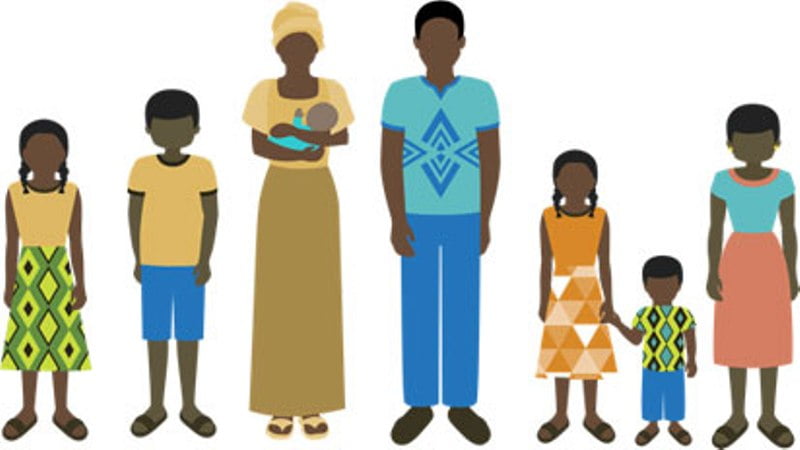When John and Josephine Adigwe got married several years back, all they could think about at that time, was making babies. Today, Josephine is a mother of eight. Faced with the current economic challenges in the country, the meagre income of her husband, a carpenter, cannot meet the needs of the family.
The family of 10 is surviving hand-to- mouth. Four of the children have dropped out of school, even as three square meals daily is a tall dream. Josephine is one of the Nigerian women of reproductive age that are not accessing contraceptives and suffering the consequences that made up the 16 percent family planning unment need, according to the 2013 Demographic Health Survey.
While the Adigwes are endangering the future of their young ones and swelling the number of dependents of the country, Godson and Tina Egwu, are working towards achieving a better future for their two children. Married 10 years after graduation, Godson, a civil servant, took it upon himself to plan his family. Exactly, 13 months after their nuptial, his wife gave birth to a baby girl. The couple agreed to seek family planning services and opted for long acting contraceptives that helped to prevent pregnancy for five years before the third child was born.
Today, their children are healthy and in school and with potential to contribute positively to the country’s economic growth. Sadly, there are more families like the Adigwes than the likes of the Godsons. Statistics from the Nigeria dividend.org show that as at mid- 2016, Nigeria had a population of 186 million, annual population growth rate of nearly 3 percent, and 44 percent of the population was under age 15. According to the data, the Total Fertility Rate, TFR, or the average number of children per woman over the course of her lifetime, declined from 6.5 in 1990 to 5.7 in 2015.
Given Nigeria’s high population size and population growth rate, even assuming a decline in total fertility rate to 3.7, the population is expected to grow to over 440 million by 2050. From the 2016/2017 Multiple Indicator Cluster Survey, MICS, Nigeria has a fertility rate of nearly 6 children per woman and a median age of 18. The survey also showed that before age 19, some women in Nigeria must have given birth to a live baby. Health watchers say although Nigeria has made bold efforts to achieve rapid economic development over the past four decades, among other factors, rapid population growth has affected the quality of life and made achievement of socio-economic development goals difficult. While launching the roadmap on harnessing demographic dividend in the youth population, the Vice President, Prof Yemi Osinbajo, expressed worry about the Nigeria’s fertility rate, saying with the youthful age structure of about half of the population under 35 years, the implication of such demographic realities for the country’s development may have consequences too grave to be ignored. Experts estimate that the window of opportunity for demographic dividend occurs when the age of the young population and the older population is between 26 and 41 years. Findings show that countries with higher fertility rate are unlikely to achieve desired levels of development across multiple sectors. But with a change in maturing age structure opens a window of opportunity across four sectors – health, education, economic and political.
In a research on “How Age Structure Change Can Benefit Development” with statistical analysis using data from over 100 countries for a period of over four decades, it was found that countries with very youthful populations almost never attain high thresholds of development. Nigeria falls among these countries.
The research specifically found that Nigeria has only 1 percent chance of achieving the Sustainable Development Goal, SDG, target of reducing under-5 mortality to less than 25 deaths per 1,000 live births. But experts say if the country invests more in reproductive health particularly family planning in areas with poor health indicators, then fertility levels may begin to decline more significantly, and children will be more likely to achieve better basic levels of health. Supporting this view, the Programme Director, Population Reference Bureau, PRB, Elizabeth Leahy Madsen, said all was not gloomy for Nigeria, if the country invests massively in child survival and child spacing, adding that such investments can turn things around. But she observed that demographic window of opportunity does not open on its own.
She said countries must provide women with voluntary family planning information and services as it helps couples achieve their desired family size and contributes to improved child health through promoting healthy timing and spacing of pregnancies.
Using historical data from countries that have achieved the child survival dividend in the research supported by Population Reference Bureau, PRB, USAID and Policy Advocacy Communication Enhanced, (PACE), Nigeria’s likelihood of achieving the child survival dividend is possible only if the country’s total fertility rate, or the average number of children a woman would have in her lifetime, continues to decline. It also showed that a faster decrease in the total fertility rate could accelerate Nigeria’s progress toward the child survival dividend.
From the statistical graph, in 2015, Nigeria has total fertility rate of 5.7 and a median age of 18 years and the likelihood of achieving the child survival dividend was 1 percent. “By 2020, Nigeria is expected to have fertility rate of 5.4 with a median age of 18 and likelihood of achieving child survival dividend is 2 percent.
By 2025, Nigeria will achieve a total fertility rate of 5.1 with median of 19 percent, and likelihood of achieving child survival dividend will be 2 percent. “In 2030, the Total fertility rate will be 4.7, median age 19 and the percent likelihood of achieving the child survival dividend increased to 2 percent. In 2035, Nigeria will have 4.4 total fertility rate with median age of 20 and the likelihood of achieving the child survival dividend will be 3 percent. By 2040, the country’s TFR will be 4.1 with a median age of 21 and likelihood of achieving child survival will be 4 percent. Also, by 2045, it will achieve 3.8 fertility rate with median age of 22 and likelihood of achieving child survival will be 6 percent. By 2050, it will achieve 3.5 total fertility rate with median age of 22 and likelihood of achieving child survival will be 8 percent.
Corroborating her views, a Reproductive Health/Family Planning Advisor, Mrs. Jumoke Adekogba, who spoke on the fertility, affects development in Health and education said “In Nigeria, more than 6 in 10 births fall in at least one of the high risk categories. This means that more than half the children born have an elevated risk of dying before their fifth birthday “At the family level, having fewer mouths to feed could help to reduce poverty and free more money to educate or help each child.”
Adekogba explained that having fewer children was a potential to increase the rate of economic growth and remain a path out of poverty for many Nigerian families. She noted that in the education sector, findings have shown that if Nigeria continues on its current path of high fertility, the number of primary school pupils will more than double by 2040. “If the country takes the path of low fertility, the nation has fewer students, there will be less pressure to build new schools and provide better health for the children,” she noted.
Calling on the government to prioritise improved access and uptake of family planning services to reduce fertility she noted that “By allowing women the freedom to control the number and spacing of their births through family planning, women will preserve their health and fertility and also contributes to improving the overall quality of their lives” She said also the effects of family planning are not immediate, long-term benefits would be seen beyond 2030, adding that mortality and morbidity due to abortion can be drastically reduced with effective family planning programming. She urged the Federal and State governments to put Family planning in their annual budget and rely less on donors.
However, as the world races towards the gains of demographic dividends, health watchers are of the view that with the launch of Nigeria’s roadmap on Harnessing Demographic Dividend through investment in youth, there is need for the government to match its words with action to ensure a robust reduction in populationa as well as ensure development is not stalled due to rapid population growth.






2 Comments